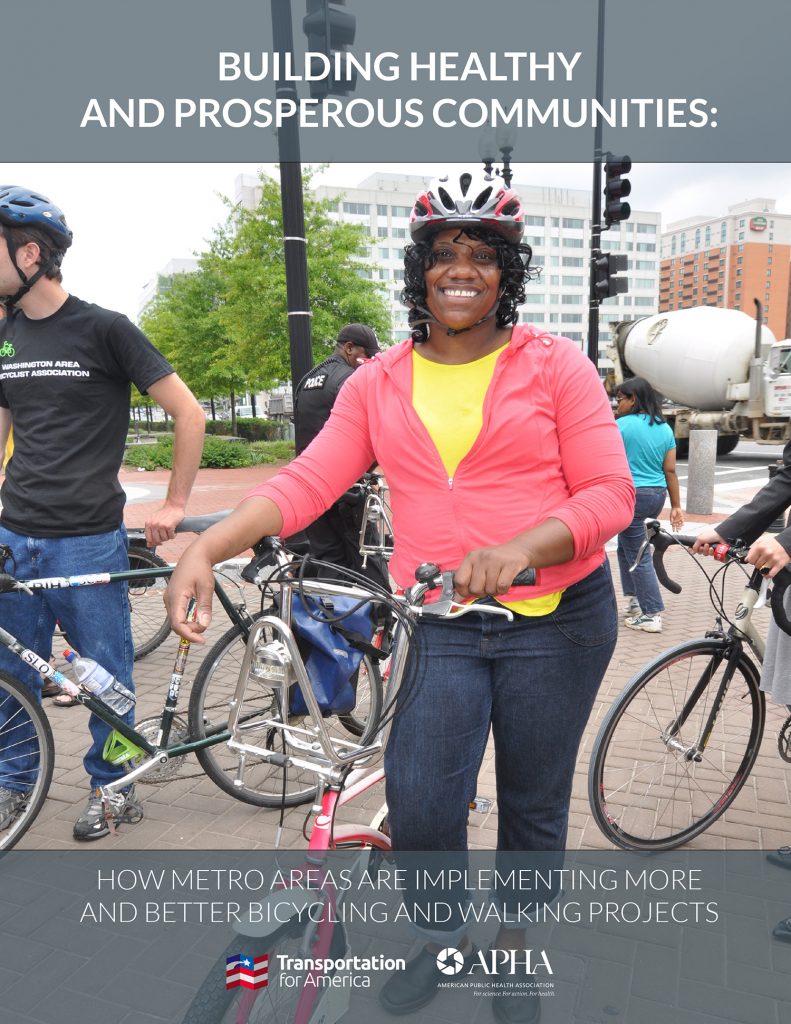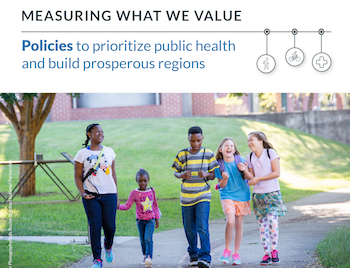Building Healthy & Prosperous Communities
How metro areas are implementing more and better bicycling and walking projects
 Metro areas of all sizes across the country are strategizing, developing, and implementing new ways to improve bicycling and walking in their regions. T4America worked with metro areas across the country to collect and document these stories, ideas, and strategies into this new guidebook.
Metro areas of all sizes across the country are strategizing, developing, and implementing new ways to improve bicycling and walking in their regions. T4America worked with metro areas across the country to collect and document these stories, ideas, and strategies into this new guidebook.
Places that have made biking and walking from place to place a safe, convenient, and enticing choice have produced positive impacts on businesses, jobs, and revenue. When it’s safer and more convenient for people to walk or bicycle as part of their regular routine, more people get the amount of physical activity that science proves they need to reduce their risk of certain chronic diseases.
How have regions successfully brought these projects to fruition? How are they integrating them into the processes of choosing what to build? How are they upending perhaps decades of radically different priorities to make these types of projects the norm?
This guidebook, produced in partnership with the American Public Health Association, tells these stories in detail, organized around seven key strategies:
1 – Design guidance for bicycling and walking projects
2 – Complete Streets policies & programs
3 – Data collection – walking & bicycle counts
4 – Performance measures
5 – Dedicated funding for bicycling and walking projects
6 – Improving walking and bicycling connections to public transportation and essential destinations
7 – Grassroots community engagement
8 – Understanding the public health impacts of transportation behaviors
Kickoff webinar
Catch up with the launch webinar on December 11, 2017. Special guests from three of the featured MPOs discussed their stories in detail and answered numerous questions from those who attended.
- Courtney Geary, of the Chattanooga-Hamilton County/North Georgia Transportation Planning Organization, shared how they created a new performance measures framework that helps prioritize multi-modal projects for funding.
- Jeff Pollack, of the Corpus Christi MPO, shared how they customized a Bicycle Mobility Network through accessibility planning and community engagement.
- Daniel Kaempff, from Metro in Portland, Oregon, shared how they changed the design of walking and bicycling projects to encourage active transportation and keep people safe.
- Rochelle Carpenter from the Greater Nashville Regional Council moderated the conversation.
The development of this guidebook was made possible through a contract between the American Public Health Association and Transportation for America funded through cooperative agreement 5U38OT000131-03 between the Centers for Disease Control and Prevention and the American Public Health Association. The contents of this document are solely the responsibility of the authors and do not necessarily represent the official views of the American Public Health Association or the Centers for Disease Control and Prevention.
Learn more about specific policies
This 2017 paper outlines four key policy levers that metro areas can use to increase and improve active transportation projects to meet the demand, decrease health disparities, increase access to opportunities, and strengthen local economies — illustrated by more than 30 short real-life examples.
Need help with implementation?
Transportation for America works in communities like yours nationwide to get better bang for their transportation buck. We can help with developing performance measures and other policies to improve project selection. Request technical assistance from T4America experts here.
Tell me more



















